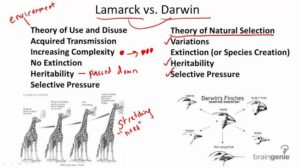Back to: ZOOLOGY 100 Level
I’m so happy to see you back, ready to conquer another fascinating topic. Today, we’re going to learn about Lamarck and Darwin, two very important scientists who had different ideas about how species evolve over time. Don’t worry; I’ll explain it in a way that’s simple and easy to understand. Let’s get started!
Lamarck vs. Darwin
Who Was Lamarck?
Jean-Baptiste Lamarck was a French scientist who proposed one of the first theories about evolution. He believed that species evolve through the use or disuse of traits and that characteristics acquired during an organism’s lifetime can be passed on to its offspring.

Lamarck’s Theory of Evolution:
- Use and Disuse: Lamarck believed that if an animal used a part of its body a lot, that part would get stronger and more developed. If an animal didn’t use a part of its body, it would get weaker or disappear.
- Inheritance of Acquired Traits: He suggested that if an animal developed a new characteristic because of its use (like a giraffe stretching its neck to reach higher leaves), that characteristic would be passed on to its offspring.
Simple Example:
Lamarck would say that if a giraffe kept stretching its neck to reach food high in trees, its neck would get longer during its life, and its babies would be born with longer necks too.
Who Was Darwin?
Charles Darwin was an English scientist who is widely known for his theory of natural selection, which explains how species evolve over time based on their ability to survive and reproduce in their environment.
Darwin’s Theory of Evolution (Natural Selection):
- Variation: Within a species, there are small differences (variations) in traits (such as size, colour, or speed).
- Survival of the Fittest: The organisms that have traits better suited to their environment are more likely to survive and reproduce.
- Inheritance of Traits: The beneficial traits that help organisms survive are passed on to their offspring.
- Over Time: Over many generations, these beneficial traits become more common in the population, and this leads to the gradual evolution of the species.
Simple Example:
If a population of giraffes has a range of neck lengths, the ones with longer necks can reach higher branches for food. These giraffes will survive longer and have more babies with long necks, making the trait more common over time.
Lamarck vs. Darwin
Let’s quickly compare their theories:
- Lamarck’s Theory: He believed that animals could acquire traits during their lifetime (like a giraffe stretching its neck) and pass them on to their offspring.
- Darwin’s Theory: He believed that evolution happens because of natural selection, where animals with traits that help them survive in their environment are more likely to reproduce and pass on those traits to their offspring.

Main Difference:
Lamarck thought traits were acquired during an animal’s life and then passed on, while Darwin believed traits were inherited through natural selection, with no need for the animal to acquire them during its life.
Summary
- Lamarck believed that species evolved because of traits they acquired during their lives and passed those on to their offspring.
- Darwin proposed the theory of natural selection, where traits that help organisms survive are inherited and become more common over time.
- While Lamarck’s ideas were groundbreaking at the time, Darwin’s theory of natural selection is now widely accepted and has been supported by more scientific evidence.
Evaluation
- What was Lamarck’s idea about how species evolve?
- Explain Darwin’s theory of natural selection.
- How do Lamarck’s and Darwin’s theories differ?
- Give an example of how natural selection works using animals.
- Why do you think Darwin’s theory is more widely accepted today?
You’re truly mastering some of the most important ideas in biology! Keep pushing forward because your knowledge will only grow stronger with each new lesson. Afrilearn is so proud of how far you’ve come, and we’re with you every step of the way.
